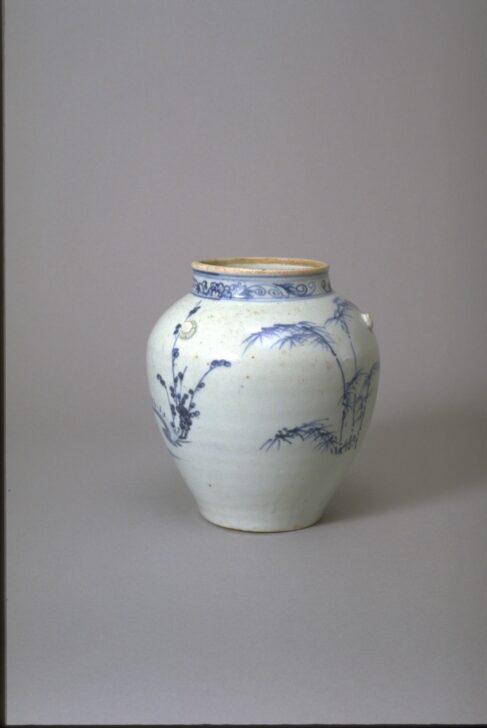Blue-and-white jar with floral and leaf design
Japanese

Description
Ceramic traditions and technologies have moved back and forth across Asia since the prehistoric period, a phenomenon that continues to this day. This piece dates from the very beginning of porcelain production in Japan, made possible by the forced immigration of a great number of Korean potters following the Japanese invasion under the military leader Toyotomi Hideyoshi (1536–1598). The more technically advanced Korean potters introduced the noborigama (climbing kilns), multichambered wood-fired kilns that can retain a high, accurate, and evenly distributed temperature. The discovery of a large deposit of prized kaolin, or porcelain clay, in the province of Hizen further contributed to the rise of porcelain making in Japan.
The combination of pine, bamboo, and plum blossom—known as the “three friends”—is a popular motif across the decorative arts of East Asia.
(Label for UMMA Japanese Gallery Opening Rotation, March 2009)
Subject Matter:
The three plants depicted here, pine, bamboo, and plum, are called “three friends in winter,” and have been depicted in many forms of Japanese decorative arts throughout its history. They symbolize long life and cultured gentlemen.
Physical Description:
A medium size, well potted jar with round shoulder and shorter neck. Inside is not totally glazed. On the body, pine, bamboo, and plum trees are finely painted with blue underglaze. Then a translucent glaze is applied, which turns into milky, white color. It has three floral decorations on the shoulder; the decoration is originated in functional elements of “ears” to which ropes were tied for transportation. The neck has a band of double lines and spray design of peony flowers and leaves. The rim of the neck is unglazed. The foot is unglazed; eye is glazed. Some imperfections of glaze are seen toward the bottom. Glaze is scraped off on one part. Many speckles on the surface.
Usage Rights:
If you are interested in using an image for a publication, please visit https://umma.umich.edu/request-image/ for more information and to fill out the online Image Rights and Reproductions Request Form.